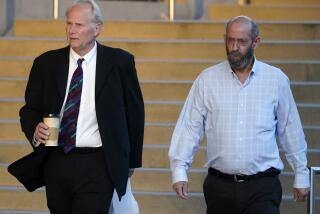Submarine’s Woes Cost Captain His Command
- Share via
SAN DIEGO — The commander of the San Diego-based submarine that snared a tugboat in June has been relieved of command because of the fatal accident and two other incidents, Navy officials said Saturday.
Citing lack of confidence, Navy officials relieved Cmdr. John H. Sohl III of his command of the nuclear-powered Houston. The submarine was on standby during the filming of the movie “Hunt for Red October” when it snagged a 1,000-foot steel cable and sank the tugboat Barcona 10 miles southwest of Long Beach.
Two tugboat crew members survived, but the pilot, Bryan Ballanger, 32, drowned. The Barcona went down in less than a minute in waters 2,500 feet deep.
Sohl, an 11-year Navy veteran, was relieved Friday. He was given a punitive letter of reprimand by Rear Adm. Michael C. Colley, Commander Submarine Force, U.S. Pacific Fleet.
The June 14 sinking, which was apparently without precedent in U.S. Navy history, was the first of three incidents that ultimately cost Sohl his command.
On July 9, Sohl was in charge when several hundred gallons of water poured in through the air ventilation system of the submarine during routine exercises and forced the crew to twice conduct emergency surfacing operations off the Southern California coast, said Lt. Sonya Hedley, spokeswoman for the U.S. Pacific Fleet’s submarine force.
The flooding caused the ship to plunge well below the surface and after an emergency de-ballasting, it resurfaced. But because it was not correctly ballasted for the surface, the Houston took a nose dive down to a depth of 350 feet. Using emergency procedures again, Sohl brought the vessel back up to “snorkeling depth,” Hedley said.
None of the 120 crew members were injured as the submarine yo-yoed up and down in the water, she said. “It was well within safety range.”
The incident was caused by a faulty valve that failed to close, said Hedley, who declined to answer whether this failure was linked to poor ship maintenance.
The third episode involving the Houston occurred last month, again off the Southern California coast. Sohl had apparently come close to an underwater obstacle, Hedley said. To avoid the obstacle, the commander backed up the submarine and the vessel’s propeller cut its sonar cable, which trails behind the submarine like a long fishing line.
On Friday, Sohl received a punitive letter of reprimand from the Navy concerning this incident, saying the Houston had cut its cable “because of improper navigation and ship operation procedures.”
In addition to these three mishaps, the Houston was plagued by other smaller troubles, sources said. Several days after the sinking of the Barcona, the Houston sliced through fishing nets in the Catalina Channel. In August, when the vessel was at sea, batter spilled out of a cake pan and smoldered, posing a potential fire hazard.
Sohl’s performance, especially the sinking of the tugboat Barcona, has been criticized by a number of Navy experts.
The Houston hooked the cable connecting the Barcona to two empty barges. The submarine pulled the tug backward and instantly yanked it down into the water. Two crew members swam to one of the barges and later saw the Houston surface 100 yards away. The submarine crew made no effort to communicate with the two men, who were picked up by a private vessel, said Ralph Larison, president of Connolly-Pacific, which owns the Barcona.
The Navy has said that the accident occurred at 4:43 a.m., but the Houston did not notify the Coast Guard until 6:40 a.m. The episode is still under investigation, and there is no explanation for the time lag, Hedley said.
“But you cannot stop a submarine on a dime,” Hedley said. “And the time lag was not for any reasons of trying to conceal anything. They came up as soon as they could.”
Others, however, were more critical.
“It bothered me that the submarine didn’t pick up the survivors,” said James Bush, a retired Navy captain and former submarine commander who now works with the Washington-based Center for Defense Information.
More to Read
Sign up for Essential California
The most important California stories and recommendations in your inbox every morning.
You may occasionally receive promotional content from the Los Angeles Times.










